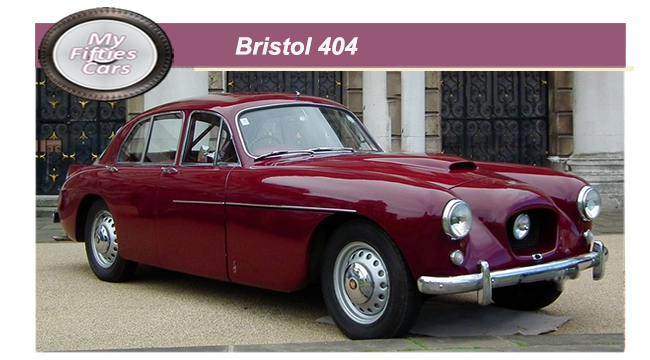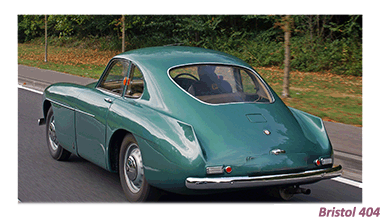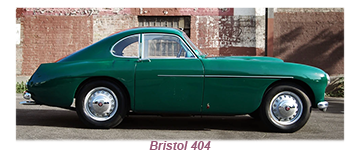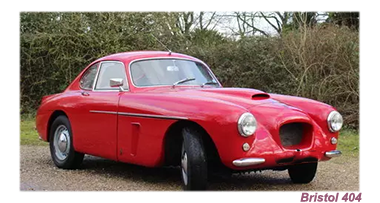
By the early Nineteen Fifties, the Bristol Car Company had polished their manufacturing capabilities to such an extent that they could combine tremendous production output with the ability to more or less handcraft their cars.
T his combination provided them with tremendous flexibility in production, certainly more than most of their counterparts in the auto industry, meaning that the company could enjoy the luxury of having two or three different models running at the same time.
his combination provided them with tremendous flexibility in production, certainly more than most of their counterparts in the auto industry, meaning that the company could enjoy the luxury of having two or three different models running at the same time.
 While the 402 and 403 models were still in production, in 1953 Bristol launched the 404, a two-door coupe but with a considerably shorter wheelbase than its nearest predecessor the 402 at 8 feet (2. 44 meters)
While the 402 and 403 models were still in production, in 1953 Bristol launched the 404, a two-door coupe but with a considerably shorter wheelbase than its nearest predecessor the 402 at 8 feet (2. 44 meters)
Once again powered by Bristol's in-house developed six-cylinder engine, the 404 was released with a completely revamped body design.
 One of its principal features of the 404's new design was the phasing out of the BMW style front grille, replaced by an “air scoop “ design said to bear a strong resemblance to an inverted jet engine.
One of its principal features of the 404's new design was the phasing out of the BMW style front grille, replaced by an “air scoop “ design said to bear a strong resemblance to an inverted jet engine.
Another new feature of the 404 was the distinctive air scoop placed on the car's bonnet, not so much as do design feature, but more to improve the flow a year to the Bristol 100B series engine.
![]()
 Thanks to its shorter stance and lower centre of gravity, coupled with a considerably more powerful engine, with output increased from 105bhp to 125bhp; the Bristol 404 reportedly provided an enhanced driving experience for those potential owners who were looking to “feel the road.”
Thanks to its shorter stance and lower centre of gravity, coupled with a considerably more powerful engine, with output increased from 105bhp to 125bhp; the Bristol 404 reportedly provided an enhanced driving experience for those potential owners who were looking to “feel the road.”
 Also passed forward from the 403, was an improved four-speed gearbox operated through a gear lever which was much shorter than its predecessors and continued the car’s sporty feel.
Also passed forward from the 403, was an improved four-speed gearbox operated through a gear lever which was much shorter than its predecessors and continued the car’s sporty feel.
 With the 404, there was little doubt that Bristol had designed this car principally as a sports car, and although marketed as a 2+2, had a really cramped interior, even for front seat passengers.
With the 404, there was little doubt that Bristol had designed this car principally as a sports car, and although marketed as a 2+2, had a really cramped interior, even for front seat passengers.
The chronic lack of space may well be the reason why Bristol decided to almost simultaneously launch their 405 model, a roomy four-door 4/5 passenger coupe.
For the 404 Bristol introduced a number of design updates that went on to become standard features in later models.
![]()
Possibly the best known is Bristol's design habit of situating both the battery and the spare wheel behind either of the car’s front wheel arches.
The 404 was also the model that introduced the Bristol feature of sizable lockers in the front wings accessed externally by dramatically fashioned “gullwing” style doors, more reminiscent of Mercedes of the era.
 The locker on the nearside wing held the spare wheel and jack, while the battery and fuse panel could be readily accessed on the offside housing.
The locker on the nearside wing held the spare wheel and jack, while the battery and fuse panel could be readily accessed on the offside housing.
The point of this exercise was apparently to provide additional storage space, usually for luggage.
 With the 404 marketed as a dual purpose vehicle, Bristol's marketing policy was to push the fact that the extra space provided could prove very useful elsewhere for the businessman while failing to mention that it was at the expense of passenger comfort.
With the 404 marketed as a dual purpose vehicle, Bristol's marketing policy was to push the fact that the extra space provided could prove very useful elsewhere for the businessman while failing to mention that it was at the expense of passenger comfort.


